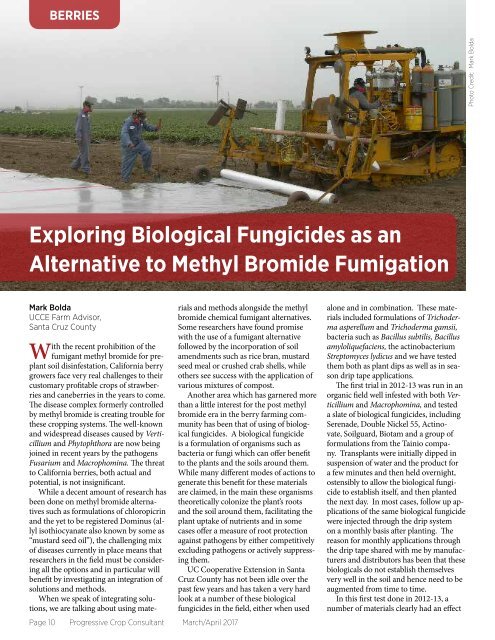Mar_Apr_PCC_2017_Web
Create successful ePaper yourself
Turn your PDF publications into a flip-book with our unique Google optimized e-Paper software.
BERRIES<br />
Photo Credit: <strong>Mar</strong>k Bolda<br />
Exploring Biological Fungicides as an<br />
Alternative to Methyl Bromide Fumigation<br />
Page 10 Progressive Crop Consultant <strong>Mar</strong>ch/<strong>Apr</strong>il <strong>2017</strong><br />
<strong>Mar</strong>k Bolda<br />
UCCE Farm Advisor,<br />
Santa Cruz County<br />
With the recent prohibition of the<br />
fumigant methyl bromide for preplant<br />
soil disinfestation, California berry<br />
growers face very real challenges to their<br />
customary profitable crops of strawberries<br />
and caneberries in the years to come.<br />
The disease complex formerly controlled<br />
by methyl bromide is creating trouble for<br />
these cropping systems. The well-known<br />
and widespread diseases caused by Verticillium<br />
and Phytophthora are now being<br />
joined in recent years by the pathogens<br />
Fusarium and Macrophomina. The threat<br />
to California berries, both actual and<br />
potential, is not insignificant.<br />
While a decent amount of research has<br />
been done on methyl bromide alternatives<br />
such as formulations of chloropicrin<br />
and the yet to be registered Dominus (allyl<br />
isothiocyanate also known by some as<br />
“mustard seed oil”), the challenging mix<br />
of diseases currently in place means that<br />
researchers in the field must be considering<br />
all the options and in particular will<br />
benefit by investigating an integration of<br />
solutions and methods.<br />
When we speak of integrating solutions,<br />
we are talking about using materials<br />
and methods alongside the methyl<br />
bromide chemical fumigant alternatives.<br />
Some researchers have found promise<br />
with the use of a fumigant alternative<br />
followed by the incorporation of soil<br />
amendments such as rice bran, mustard<br />
seed meal or crushed crab shells, while<br />
others see success with the application of<br />
various mixtures of compost.<br />
Another area which has garnered more<br />
than a little interest for the post methyl<br />
bromide era in the berry farming community<br />
has been that of using of biological<br />
fungicides. A biological fungicide<br />
is a formulation of organisms such as<br />
bacteria or fungi which can offer benefit<br />
to the plants and the soils around them.<br />
While many different modes of actions to<br />
generate this benefit for these materials<br />
are claimed, in the main these organisms<br />
theoretically colonize the plant’s roots<br />
and the soil around them, facilitating the<br />
plant uptake of nutrients and in some<br />
cases offer a measure of root protection<br />
against pathogens by either competitively<br />
excluding pathogens or actively suppressing<br />
them.<br />
UC Cooperative Extension in Santa<br />
Cruz County has not been idle over the<br />
past few years and has taken a very hard<br />
look at a number of these biological<br />
fungicides in the field, either when used<br />
alone and in combination. These materials<br />
included formulations of Trichoderma<br />
asperellum and Trichoderma gamsii,<br />
bacteria such as Bacillus subtilis, Bacillus<br />
amyloliquefaciens, the actinobacterium<br />
Streptomyces lydicus and we have tested<br />
them both as plant dips as well as in season<br />
drip tape applications.<br />
The first trial in 2012-13 was run in an<br />
organic field well infested with both Verticillium<br />
and Macrophomina, and tested<br />
a slate of biological fungicides, including<br />
Serenade, Double Nickel 55, Actinovate,<br />
Soilguard, Biotam and a group of<br />
formulations from the Tainio company.<br />
Transplants were initially dipped in<br />
suspension of water and the product for<br />
a few minutes and then held overnight,<br />
ostensibly to allow the biological fungicide<br />
to establish itself, and then planted<br />
the next day. In most cases, follow up applications<br />
of the same biological fungicide<br />
were injected through the drip system<br />
on a monthly basis after planting. The<br />
reason for monthly applications through<br />
the drip tape shared with me by manufacturers<br />
and distributors has been that these<br />
biologicals do not establish themselves<br />
very well in the soil and hence need to be<br />
augmented from time to time.<br />
In this first test done in 2012-13, a<br />
number of materials clearly had an effect


















